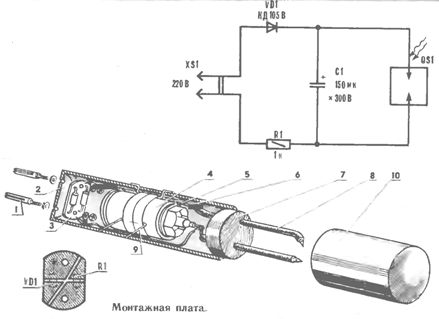Categories: Featured Articles » Practical Electronics
Number of views: 33373
Comments on the article: 2
How to make an electronic match
 They say that you won’t save much on matches, and yet ... A simple and practical electronic match, the description of which I propose, will save you from the need to constantly monitor so that the matchboxes do not remain empty.
They say that you won’t save much on matches, and yet ... A simple and practical electronic match, the description of which I propose, will save you from the need to constantly monitor so that the matchboxes do not remain empty.
The “match” acts as follows. The electric power accumulated by capacitor C1 (see the circuit diagram) from the 220 V network is converted into a spark, from which gas ignites in the burner of the stove. The charge time C1 to the amplitude value of the mains voltage is 2 - 3 s, and for its discharge, only 0.1 s is sufficient.
Structurally, the “match” is made in the form of a cylinder consisting of two halves (see. Figure). Radioelements are located inside one, the other protects the ends of the arrester from accidental short circuit, otherwise a “match” connected to the network immediately destroys the VD1 diode, which protects from shock by the discharge of capacitor C1 (when touching the current collectors of a plug removed from the power outlet), since relative to the polarity of the voltage across it, the diode is turned on in the opposite direction.
Match ”is assembled from any materials at hand. As a composite case used plastic bottles from under the shampoo with a length of 100 mm. Under their dimensions, the dimensions of the parts are selected.
Two holes for current collectors are drilled at the bottom of the housing from a standard power plug, the distance between which is designed for the corresponding outlet. Six more holes with a diameter of 1 mm are made on the side - two in increments of 120about - for fastening the capacitor.
Then, a mounting plate is made of fiberglass fiberglass with a thickness of 1-1.5 mm. The foil is cut with a knife on the L segment (see. Fig.), To which the diode and resistor are soldered, as well as multicore insulated wires 150 mm long for connection to the capacitor. The board is mounted on the inside of the case using current collectors and nuts.
The arrester is made of welding electrodes of 2.5 mm. Chlorovinyl tubes are put on them and inserted into the holes of the wooden holder. From one end, the spark gap electrodes are sharpened with a file, and from the other they are soldered to the terminals of the capacitor. Moreover, the areas of electrodes intended for soldering are pre-wrapped with tinned copper wire with a diameter of 0.2 mm.

The electrical circuit "matches"
Matches design: 1 - current collectors, 2 - case, 3 - mounting plate, 4 - capacitor, 5 - soldering wire, 6 - electrode, 7 - wooden holder, 8 - vinyl tube, 9 - fixing bracket, 10 - cap
Using electrical tape on the capacitor housing, fix in increments of 120about three brackets of copper wire with a diameter of 1 mm, with a margin of length. The wires coming from the board are soldered to the capacitor, and then, having threaded the ends of the brackets into the holes on the side of the case, they insert a capacitor together with a spark gap into it half the length of the wooden holder. A patch of Moment glue is pre-applied to this area to fix the holder in the housing. In addition, outside the brackets of the brackets bend along the outside, thereby fixing the “insides” of the structure. Their excess is cut along the length, and the remaining ends of the staples are glued to the body or wrapped with electrical tape.
A protective cap is put on the other half of the electrode holder located outside the housing.
An “electronic match” can be constantly plugged into a power outlet, so it is always ready to go. To ignite the burner of the gas stove, the "match" is removed from the outlet, the protective cap is removed, brought to the burner, the gas is opened and the spark gap is compressed until the sharply sharpened ends of the electrodes are closed - a spark arises. When the arrester is released, the elastic electrodes return to their original position.Put on a protective cap, and the "match" is again inserted into the power outlet until the next time.
With prolonged use, the surface of the electrodes becomes “knocked out” over time. Therefore, it is periodically necessary to file with a file the places of their mutual contact, so that the ends of the spark gap are always sharpened for concentration in a narrow part of the discharge energy of the capacitor.
The diode can be replaced with any other with close parameters.
See also: Useful electronic homemade products (best articles)
See also at bgv.electricianexp.com
:
